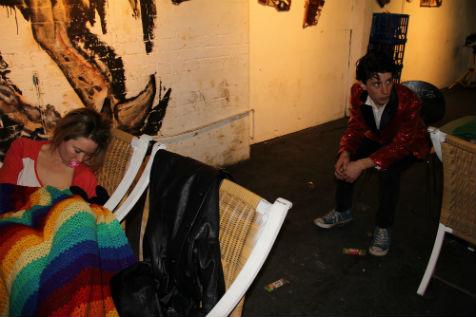Deciding to take part in a Fringe Festival begins with an idea and a click of the mouse. Where it leads, you can never be sure, but in the simple act of applying, you’re taking the first step towards possibility.
After a successful season at the Sydney Fringe, our production of Philip Ridley’s haunting black comedy, The Pitchfork Disney, was invited back to the Sidetrack Theatre for an encore season, beginning on 5 December.
Having had such a brief run for the festival, the invitation elicited smiles all round – we’d entered the Fringe with no expectations, and had been rewarded with a reprise. There was only one issue: the official invitation to remount the production landed in our laps only three weeks before the season was due to begin.
So, whilst the cast and crew were elated at the opportunity to slip back into the skin of the show, the option to remount also came with its fair share of ‘umms’, ‘ahhs’, ‘could wes’ and ‘should wes’. Not only would this mean that we would have less than three weeks to raise the funds for the remount (the budget for which ended up being almost equivalent to that of our original run), but also less than three weeks to relaunch and reinvigorate our marketing campaign (we would need to extend our audience outside our inner circles, as a majority of our family and friends had already seen the show). All this, with the added pressure of having to re-cast and rehearse one of the characters.
Challenging? Yes. Impossible? No, as now, almost three months after closing our Fringe season, we find ourselves with another opening night mere days away. All thanks to the dedication of a talented cast and crew, and to the possibilities that arise from the Fringe.
The Fringe means something different to every artist. For many, it’s an opportunity to explore and experiment; a platform on which to try something out, see if it works, and test audience responses. For some, the Fringe provides an opportunity to stage a show without some of the pressures of independent production. For others, the Fringe is all about being a part of a community of fellow arists, brought together under the big, fuscia banner of the Fringe. For me, the Fringe was an incentive to get up and create, and gave me the confidence to know that if I can do it for the Fringe, I can do it on my own.
So, whether you’re an aspiring Fringe-er looking to make their debut in 2013, or a current Fringe-er looking to take the next step, here are a few things I’ve learned along the way:
1)
Just do it
This is the first and foremost thing. Don’t let the fear of a heavy workload or new challenges get in your way. Of course there’s going to be lots to do, and of course it will be challenging. But once you’ve done it once, it will be so much easier the second, third and fourth times around.
2)
Talk to other directors/producers/artists
Knowing that others can do it, and are doing it, is a great way to instill confidence and productivity into a project.
3)
Ha Get someone on board to help you out
If you’re planning on producing and directing/acting in the project yourself, find someone you can work well with to help produce the show. This may be a fellow actor, a designer, or someone otherwise external to the project. Never underestimate the usefulness of sharing your load.
4) Learn everything you can about publicity
What with all the other shows taking place during the Fringe, a good marketing campaign is essential. The Fringe can help you out with reduced publicity rates, but in the end it all comes down to you. Flood social media, get in touch with publications and hit up every ‘what’s on’ website you can find.
5) Invite reviewers
There’s always a chance your ego will be bruised, but on the other end of the spectrum, you’ll have some stellar quotes to pop under your name! And if they get in early enough, that’s potentially a couple of extra bums on seats.
6) Head along to other Fringe shows
Yes, you’re busy, but take the time out of your project to see and talk to other Fringe artists. You might learn a thing or two from their Fringe process, and if nothing else, supporting those in the same position as you is great indie karma.
7) Follow up
Now that you’ve produced a show for the Fringe, and now you know you can do it, do it again! Before you get a chance to be thwarted by the enormity of the task, plan your next project. Whether it be taking this Fringe show to the next level, touring, or creating a new show for one of the many other Fringe festivals around the world, now is the perfect time to keep the ball rolling. You never know where it might end up.
The Pitchfork Disney is playing at Sidetrack Theatre, Marrickville from 5 to 9 December.





